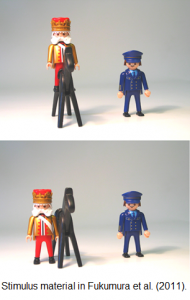When speakers refer to a previously mentioned discourse entity, they can do this in a variety of ways, for example, using a pronoun or repeating an earlier produced noun phrase or name.  In a series of experiments, Kumiko Fukumura (University of Stirling) and Roger van Gompel have investigated the different factors that affect the choice of referring expression. This research suggests that syntactic factors (Fukumura & Van Gompel, 2015) and visual saliency (Fukumura, Van Gompel, & Pickering, 2010) play an important role in the choice of referring expression, but the likelihood with which an antecedent is referred to does not (Fukumura & Van Gompel, 2010). The similarity between the referent and competitors also has an effect: speakers choose more explicit referring expressions when the competitors are visually similar or have the same animacy, (Fukumura, Van Gompel, Harley, & Pickering, 2011; Fukumura & Van Gompel, 2011). We have also investigated whether speakers choose more explicit referring expressions (e.g., full noun phrases instead of pronouns) to help the addressee identify the referent. Our results suggest that they take into account the visual saliency of the referent to the addressee, but not the linguistic saliency (Fukumura & Van Gompel, 2012; Kantola & Van Gompel, 2015).
In a series of experiments, Kumiko Fukumura (University of Stirling) and Roger van Gompel have investigated the different factors that affect the choice of referring expression. This research suggests that syntactic factors (Fukumura & Van Gompel, 2015) and visual saliency (Fukumura, Van Gompel, & Pickering, 2010) play an important role in the choice of referring expression, but the likelihood with which an antecedent is referred to does not (Fukumura & Van Gompel, 2010). The similarity between the referent and competitors also has an effect: speakers choose more explicit referring expressions when the competitors are visually similar or have the same animacy, (Fukumura, Van Gompel, Harley, & Pickering, 2011; Fukumura & Van Gompel, 2011). We have also investigated whether speakers choose more explicit referring expressions (e.g., full noun phrases instead of pronouns) to help the addressee identify the referent. Our results suggest that they take into account the visual saliency of the referent to the addressee, but not the linguistic saliency (Fukumura & Van Gompel, 2012; Kantola & Van Gompel, 2015).
LangProLab
Language Processing Lab | University of Dundee
